HomeMain MenuAmateur RadioAboutActivitiesAntennasIdentities |
|
Bruce H. McIntosh scotsman@afn.org Visit my work homepage Last revised Jan 04, 2021 |
Invisible airwaves crackle with life
Bright antennas bristle with the energy
Amateur Radio
Four Element Yagi for 6 Meters
Whenever there's a VHF contest on the horizon,I get motivated to launch into a frenzy of last-minute antenna-building. The January 2008 ARRL VHF Sweepstakes was no exception. I had designed a fairly conservative yagi for 6 meters over the previous summer. The goals were to get somewhat better gain than either the Moxon I had up,or the 3 element Yagi I'd originally used (and which is now my portable 6m antenna),and to do it on a fairly short boom (the better to dodge the next door neighbor's trees hanging over the fence). I played around with several configurations,using the W9CF Java Yagi Optimizer,finally settling on 4el on an 8' boom. The numbers aren't the greatest,particularly f/b,but I figured it'd be good enough until I could get the neighbor to trim his trees or until I could move the VHF tower back a few feet. When one of those happens,I'll see about rebuilding the antenna as a 6el OWA on a 16' boom. (Note: I'm pretty sure these where the numbers I used, as none of my other simulated runs hit any decent combination gain and f/b while maintaining a 50ohm feedpoint.)
| Element | Length | Position |
|---|---|---|
| Reflector | 115" | 2" |
| Driven Element | 110" | 33" | Director 1 | 108.75" | 44.5" | Director 2 | 108" | 94" |
I ordered the raw materials from McMaster-Carr - 1/2" and 3/8" aluminum for the elements,UHMW plastic for the mounting plates,and all the requisite galvanized and stainless steel hardware to put it all together. I got the mounting plates cute out and drilled,and the elements cut,but I never got 'round to finishing it. One night few days before the contest the wife and kids were off at a 4H meeting,so I decided to take my sore throat and impending cold and work on the yagi out in the damp and chill of the garage (Yes, it does get cold in Florida!).
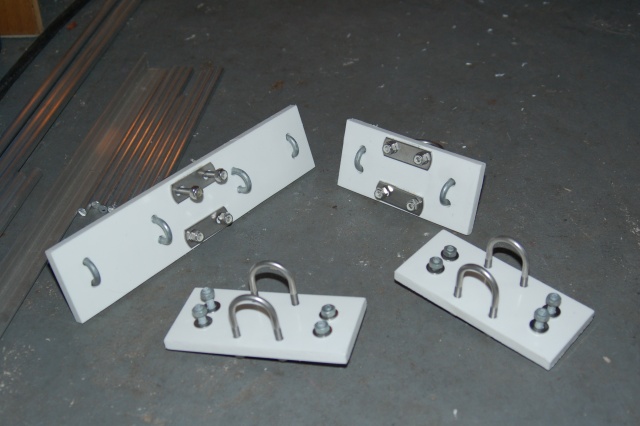
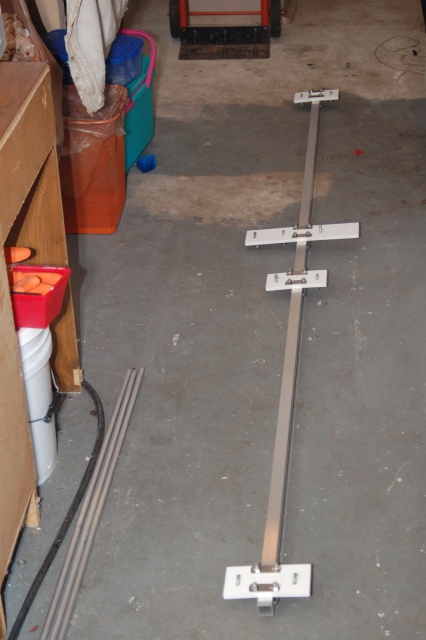
The mounting plates for the elements are cut from a piece of UF-resistent 1/2" thick UHMW plastic. The big plate is of course for the driven element,which is split into two pieces and directly fed by the coax. I like designing and building antennas with direct 50 ohm feeds,because I'm too lazy/sloppy/whatever to make gamma or tee matches or whathaveyou. "Easy" and "fun" are closely related in my hobbytime activities! The boom is an 8' length of 1" square aluminum tubing from Lowes. I'd purchased two of them in hopes of making a bigger antenna,but the aforementioned tree limb obstacles scotched that plan.
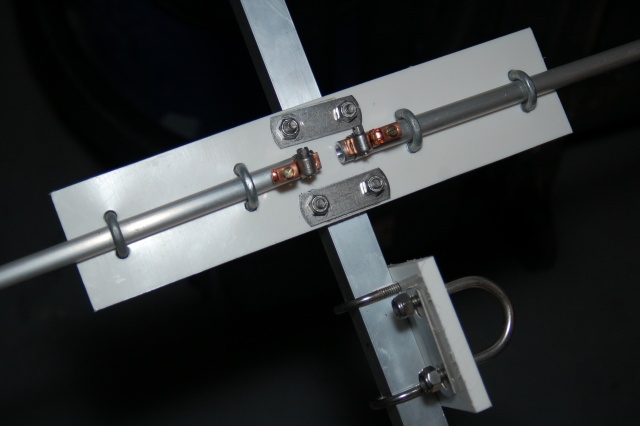
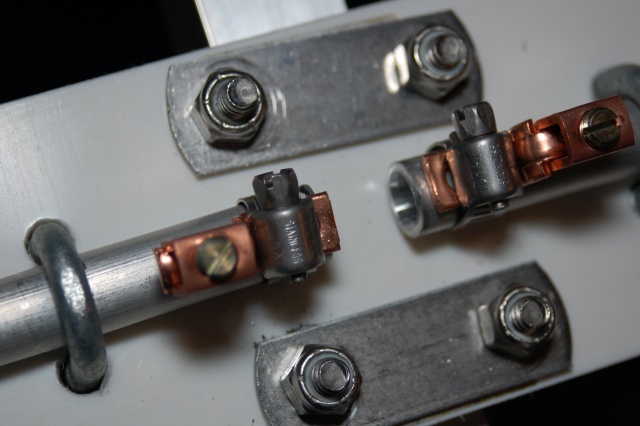
The feed point is 50 ohms,suitable for direct feed. It consists of a couple of offset electrical wiring lugs held to the driven element halves with stainless cable clamps. a short length of coax is connected to the lugs,then wound into a choke balun. The choke balun has a PL-259 connector on it.
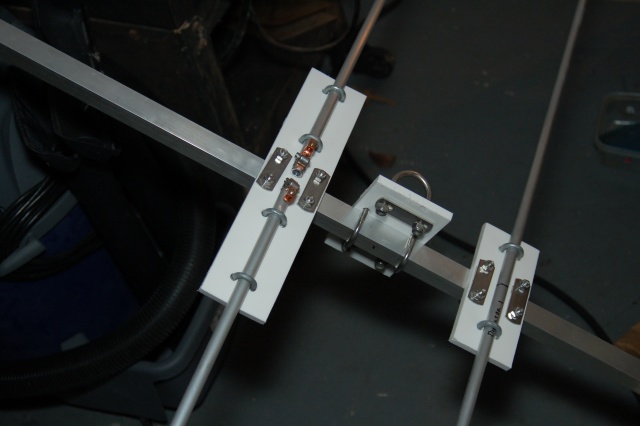
I'd realized once I got the plates on the boom that I'd neglected to do a
boom-to-mast mounting plate. This was remedied in short order. When I
first contemplated the design of this antenna,I was figuring on five
elements on a 16' boom; the two 8' lengths of square tubing would have been
spliced with a couple of lengths of aluminum L-shaped stock which would have
provided convenient places for the mast clamp u-bolts. Once I realized that
8' was about the longest I could make the antenna,a conventional mast
mounting plate became necessary.
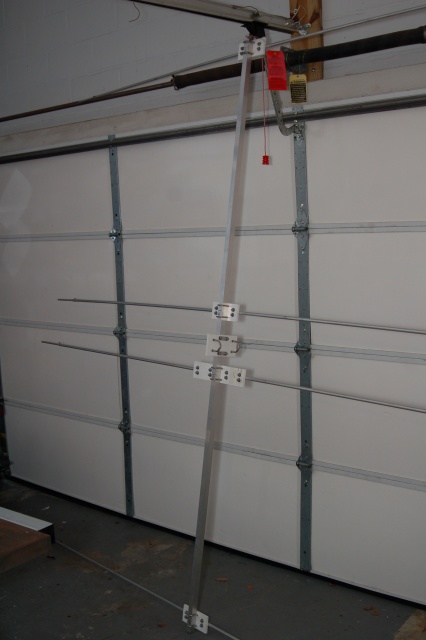
I finished assembling the antenna Friday night before the VHF contest. I had a very bad moment when I realized that,with an 8' boom and 8' long elements,this critter was not going out the back door no way no how. Then I remembered,"D'oh! This is the garage! That's the garage door the antenna's leaning against!" The things an ongoing lack of sleep (or, my teenager will tell you, my advancing decrepitude - cut me a break, Marie, I'm only in my 40s!) will do for you...
Actually putting it up had to wait until Saturday afternoon after the SouthCARS January meeting and lunch up in Valdosta. K4GLM Shannon rode with me to Valdosta; in lieu of paying for gas I drafted him to help me lower the VHF mast,rig it with some pulleys and rope to make it easier to get back up again,and mount the new Yagi. We got the mast hauled back up,only to discover that we hadn't hooked the feedline to the antenna. Once that was remedied,it was time to head inside out of the torrential downpour that erupted,and start the contesting.
So how'd the antenna do on the air? That was hard to say. 6 was clearly hopping,with stations spread from 50.125 clear up over 50.200. I dove in,made a couple of contacts,and everything suddenly went silent. Not a peep. That was not good. A quick check with the dummy load and trusty Bird wattmeter showed that the radio hadn't let go; it was putting out 100W. Time to drop the mast again and put the dummy load at the far end of the feed. Uh oh,dead short - waterlogged PL-259 had failed (Did I forget to mention the torrential downpour?). By the time I got the cable hauled in the window,the dead end cut off and a new PL-259 intalled,the cable stuffed back out the window and connected to the antenna,and the mast hoisted back to vertical,6m had closed (NATURALLY (thanks, Brother Murphy!)). I only logged 14 contacts for the whole contest,split more or less evenly between 6 and 2.
Over the next few months,not much happened in the way of band openings,though I did manage a few local QSOs. I got good signal reports relative to the prior Moxon,and was reasonably content. Then came the June VHF QSO party. Lordy lordy lordy! I thought my hand would cramp scribbling all those contacts down! (Yes, I write my contest logs by hand and type them in later - I don't have a boom mike or footswitch on any of the VHF rigs, so I need one hand to hold the mic.) The new Yagi performed beautifully,as did an even newer 15 element Yagi for 70cm (but that's another story).